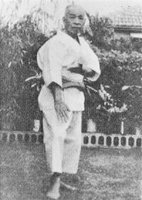Education....?

Was Chibana an uneducated man? Chibana’s formal education ended when he dropped out of an
First, Chibana’s teacher, Itosu, was a scholar and bureaucrat. As a youth from a reputable and well-to-do family, Itosu was schooled in the Chinese classics, Confucianism, and calligraphy. His writing abilities, scholarship, and character earned him the position as soushi koori, Secretary for the
Having been schooled in Confucian thought, Itosu would naturally be respectful but demanding of his relationship as a teacher with his students. In researching Itosu’s character, karate historian Mark Bishop notes, “[Itosu] had been a kind but stern father figure to his students” (4). Shinpan Shiroma reports that Itosu was cautious and strict (5).
Given these characteristics of Itosu – an educated, classically trained scholar and bureaucrat who devoutly subscribed to Confucian thought, and was thus a strict father figure to his disciples – it is very difficult to accept that in the fifteen years Chibana spent with him as his disciple that Itosu would not have somehow completed Chibana’s schooling at least informally. As a product of a well-to-do family, Itosu was raised on the mantra of bun bu ryodo – culture/philosophy, martial arts, calligraphy. He would have likely passed this on to the fifteen-year-old Chibana. While possibly unrelated, some evidence of this can be seen in Chibana’s fondness for practicing calligraphy.
Second, John Sells notes that Toyama Kanken claimed to have been awarded the privilege of bestowing rank in any martial art by the Ministry of Education, and the only other person to share the privilege was Chibana (6). If this is so, it may be reasonable to posit that the ministry responsible for the education of Japanese children would not want to honor or elevate an individual who had not at least demonstrated some competence in a basic Japanese education; in his dealings with the ministry, Chibana must have shown that he had at least the equivalent of a high school education. Even if his influence was restricted purely to physical education, it is not logical for a school system to honor a junior high school dropout if that is as far as his education appeared to have gone.
Third, for an uneducated man, Chibana seemed to have a very academic perspective on karate. According to Chibana, Itosu did not just train karate. “Sensei Itosu studied very hard at karate” he remarked to Katsumi Murakami, author of Karate-do to Ryukyu Kobudo (7). Chibana was a principal member of the Ryukyu Tode Kenkyukai, or the Ryukyu Tode Research Club. In 1929, he christened the dojo he opened at Baron Nakijin’s courtyard in
Was Chibana an uneducated man? Formally, yes. However, given these three factors, it becomes increasingly difficult to blindly embrace the concept. It is troublesome to envision a disciple of a learned scholar, a darling of the Ministry of Education, and a man with a hunger for study and learning as a crude simpleton who spoke his mind and thought nothing of it.
Notes:(1) John Sells, Unante, 2nd Edition (Hollywood: W.M. Hawley Library, 2000), pg. 189
(2) Shoshin Nagamine, Tales of Okinawa's Great Masters, (Boston: Tuttle Martial Arts, 2000), pg. 47
(3) Ibid
(4) Mark Bishop, Okinawan Karate, 2nd Edition, (Boston: Tuttle Martial Arts, 1999), pg. 90
(5) Ibid
(6) Sells, pg. 109
(7) Graham Noble, "Masters of the Shorin-Ryu: Part II", Fighting Arts International (Issue 51, Volume 9, No. 3 pg. 32-35), available online (http://seinenkai.com/articles/noble/noble-shorin2.html), par. 23
(8) Bishop, pg. 91
(9) Noble, par. 32
(10) Patrick Nakata, "Okinawa Shorin-Ryu Karate", (introductory handout), pg. 1

